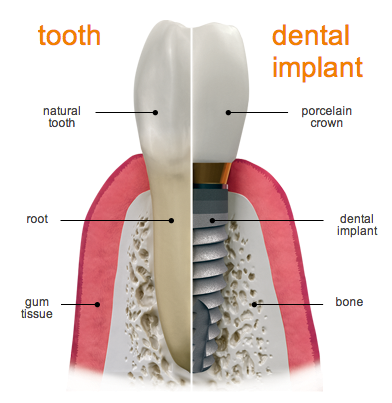
Dental Implants

Dental implants as we know them today were invented in 1952 by a Swedish orthopedic surgeon named Per-Ingvar Brånemark. Today, they are considered the standard of care for prosthetic replacement of missing teeth in dentistry. A dental implants is a surgical fixture that is placed into the jawbone and allowed to fuse with the bone over the span of a few months. The dental implant acts as a replacement for the root of a missing tooth. In turn, this “artificial tooth root” serves to hold a replacement tooth or bridge. Having a dental implant fused to the jawbone is the closest thing to mimicking a natural tooth because it stands on its own without affecting the nearby teeth and has great stability. The process of fusion between the dental implant and jawbone is called “osseointegration.” Most dental implants are made of titanium, which allows them to integrate with bone without being recognized as a foreign object in our body. Over time, technology and science have progressed to greatly improve the outcomes of dental implant placement. Today, the success rate for dental implants is close to 98%.
What is the procedure ?
If you are considering dental implants, you need to have healthy gums and adequate bone to support the implant. If your bone is too thin or soft and unable to support an implant, you may require a bone graft. Or if there is not enough bone height in the upper jaw or the sinuses are too close to the jaw you may require a sinus lift. A sinus lift is a surgery performed by an oral surgeon or a periodontist. During surgery bone is added to the upper jaw between the jaw and the maxillary sinuses, in the area of the molars and premolars. Implants are usually more expensive than other methods of tooth replacement. If you are missing a tooth and believe a dental implant might be the right solution for you, start by consulting your dentist.
American Dental Association considers two types of dental implants to be safe for use. They are:
Endosteal Implants
These are the most common type of implant and are surgically placed directly into the jawbone, they are also called root-form implants. These are typically shaped like small screws, cylinders or plates. In order for an endosteal implant to be successful the bone needs to be deep and wide enough to provide a secure foundation. Once the surrounding gum tissue has healed, a second surgery is needed to connect a post to the original implant. Finally, an artificial tooth (or teeth) is attached to the post-individually, or grouped on a bridge or denture.
Subperiosteal Implant
This type of implant consists of a metal frame that is fitted onto the jawbone just under the gum tissue. As the gums heal, the frame becomes fixed to the jawbone. Posts, which are attached to the frame, protrude through the gums. As with endosteal implants, artificial teeth are then mounted to the posts.
What are the benefits ?
A dental implant can do wonders for self-esteem, because it feels and looks like a normal tooth. Many people who were shy about smiling because of a space from a lost tooth feel more comfortable after a dental implant. Beyond the aesthetics, a dental implant also makes it easier to eat and speak, because a titanium post secured directly in the jaw holds the implant in place.
What care should be taken ?
Good oral health habits are required for the implant. You must floss once daily and brush your teeth two to three times at day. In addition, you should visit your dentist every six months for an exam and cleaning appointment.


Before & After
Need more advice ?
Contact us by email on shiningsmilecare@gmail.com or call 9011079677 / 8263962023.
